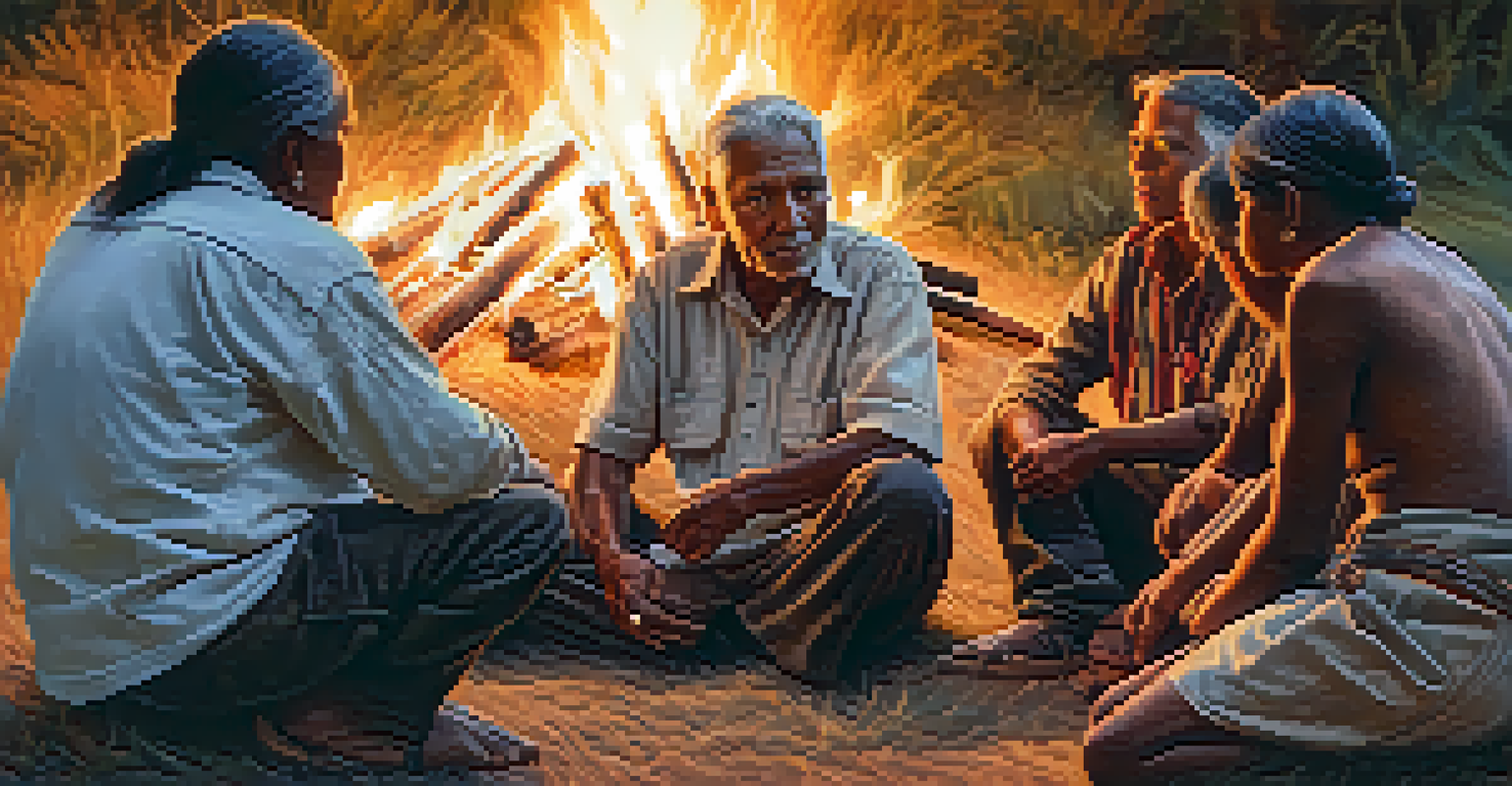Healing and Identity: Peyote's Impact on Indigenous Groups

Understanding Peyote: A Sacred Plant in Indigenous Traditions
Peyote, a small cactus native to North America, is revered among various Indigenous tribes for its psychoactive properties. Traditionally, it has been used in spiritual ceremonies, promoting healing and connecting individuals with their heritage. The use of peyote is not merely recreational; it carries profound significance in the cultural practices of groups like the Native American Church, where it serves as a bridge to the divine.
The use of peyote in healing is not just about the plant; it's about the journey of reconnecting with our true selves and our heritage.
For many Indigenous peoples, peyote symbolizes a connection to their ancestors and the earth. It’s often consumed during rituals that aim to foster community, healing, and personal reflection. This sacred plant encourages participants to explore their inner selves, leading to a deeper understanding of their identity and place in the world.
As we delve deeper into the role of peyote, it becomes clear that its impact extends beyond individual experiences. It plays a crucial role in preserving cultural traditions and fostering unity within communities, making it an essential aspect of Indigenous identity.
The Healing Properties of Peyote in Indigenous Practices
Peyote is imbued with healing properties that many Indigenous groups have recognized for centuries. Users often report profound emotional and psychological healing during peyote ceremonies, which can help address trauma and spiritual disconnection. This plant provides a unique avenue for introspection, allowing individuals to confront and process their experiences.

In many ceremonies, participants gather in a circle, sharing their stories and seeking guidance from one another and the plant. This communal aspect of peyote use fosters a sense of belonging and support, essential for healing processes. The shared experience creates a safe space for vulnerability, which can be remarkably transformative.
Peyote's Role in Healing Practices
Peyote is recognized for its profound healing properties, facilitating emotional and psychological recovery in communal ceremonies.
Furthermore, the healing journey facilitated by peyote is often viewed as a pathway to reclaiming identity. As individuals confront their struggles, they also reconnect with their heritage and culture, allowing for a more profound sense of self and community.
The Role of Peyote in Cultural Identity Among Indigenous Peoples
Peyote plays a vital role in shaping cultural identity for many Indigenous groups. Its use in rituals reinforces traditional values and practices, creating a sense of continuity with the past. By engaging with peyote, individuals not only honor their ancestors but also affirm their cultural identity in a rapidly changing world.
Peyote serves as a reminder that our culture is alive and thriving, a testament to our resilience in the face of adversity.
As Indigenous communities face challenges such as assimilation and loss of land, peyote ceremonies serve as a powerful reminder of their resilience and cultural integrity. These gatherings provide a space for storytelling, passing down traditions, and strengthening communal ties, all of which are crucial for maintaining cultural identity.
Moreover, the act of using peyote can be seen as a form of resistance against colonial narratives that aim to erase Indigenous cultures. By embracing their heritage through peyote, these communities reclaim their narratives and assert their existence and rights within society.
Legal Controversies Surrounding Peyote Use
Despite its significance, peyote use is not without controversy, particularly regarding its legal status. In the United States, peyote is classified as a Schedule I controlled substance, which complicates its use in traditional ceremonies. This legal framework often poses challenges for Indigenous peoples who seek to practice their cultural traditions freely.
However, some legal protections exist for specific Indigenous groups, allowing them to use peyote in religious ceremonies. The American Indian Religious Freedom Act, for example, recognizes the importance of peyote for the Native American Church. Yet, these protections can be inconsistent and vary by state, creating ongoing tension between cultural practices and legal restrictions.
Cultural Identity and Resilience
The use of peyote reinforces cultural identity among Indigenous peoples, serving as a powerful form of resistance against colonial narratives.
The debate surrounding peyote legalization highlights broader issues of Indigenous rights and sovereignty. Advocates argue that legal access to peyote is crucial for the survival of cultural practices and the well-being of Indigenous communities. As discussions continue, the future of peyote use remains a significant topic in the fight for Indigenous rights.
Peyote and Contemporary Indigenous Identity
In today's world, peyote continues to be a potent symbol of contemporary Indigenous identity. For many younger generations, engaging with peyote rituals offers a way to connect with their heritage amid modernization and globalization. This connection fosters a renewed sense of pride in cultural identity, allowing them to navigate contemporary challenges while honoring their past.
The resurgence of interest in peyote among Indigenous youth often coincides with broader movements for cultural revitalization. By participating in peyote ceremonies, they not only reclaim their cultural practices but also strengthen their community ties. This blend of tradition and modernity exemplifies the dynamic nature of Indigenous identity today.
Additionally, as more Indigenous voices advocate for their rights, peyote remains a powerful tool for cultural expression and social justice. The ongoing use of peyote in ceremonies reinforces the importance of cultural heritage and the need for self-determination in Indigenous communities.
Stories of Healing: Personal Experiences with Peyote
Many individuals have shared transformative stories about their experiences with peyote during ceremonies. These personal narratives often highlight how peyote facilitates emotional breakthroughs, helping participants to confront deep-seated traumas. For some, the experience can lead to profound insights, promoting healing and a renewed sense of purpose.
One common theme in these stories is the feeling of connectedness—both to oneself and to others. Participants often describe a bond that forms during ceremonies, where shared experiences create a sense of community. This connection can be incredibly healing, reinforcing the idea that no one is alone in their struggles.
Legal Challenges for Peyote Use
Despite its cultural significance, peyote faces legal controversies that complicate its use in traditional ceremonies for Indigenous groups.
Furthermore, these stories serve as a testament to the enduring power of peyote in Indigenous cultures. They illustrate how, even in modern times, peyote remains a vital source of healing, identity, and connection for many individuals seeking a deeper understanding of themselves and their place in the world.
The Future of Peyote and Indigenous Healing Practices
Looking ahead, the future of peyote and its role in Indigenous healing practices is a topic of both hope and concern. As awareness of Indigenous rights and cultural practices grows, there is potential for greater acceptance and legal protections for peyote use. This shift could enable more individuals to engage in traditional practices, fostering healing and community resilience.
However, challenges remain, including the risk of overharvesting and the need for sustainable practices. As demand for peyote increases, it’s crucial to balance cultural use with environmental stewardship. Indigenous communities are leading efforts to cultivate peyote sustainably, ensuring that this sacred plant is preserved for future generations.

Ultimately, the future of peyote is intertwined with the broader struggles for Indigenous rights and sovereignty. By advocating for cultural recognition and sustainable practices, Indigenous communities can continue to harness the healing power of peyote while fostering a stronger sense of identity and belonging.